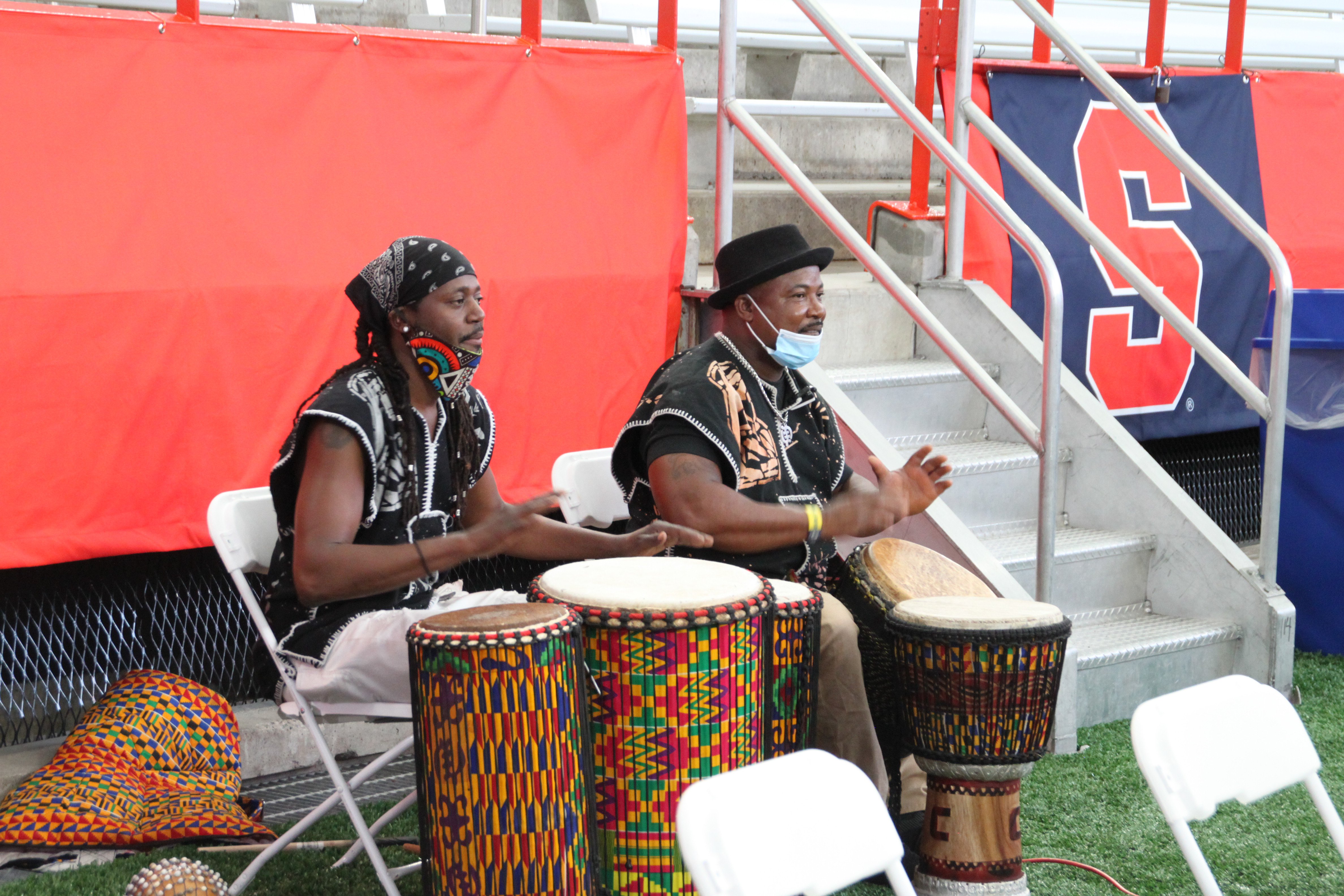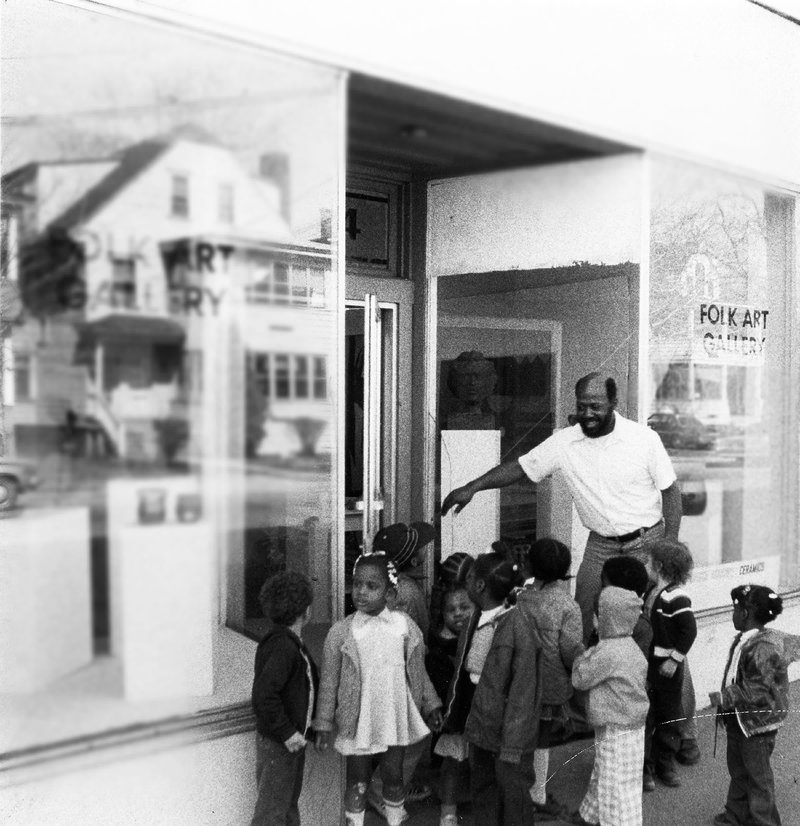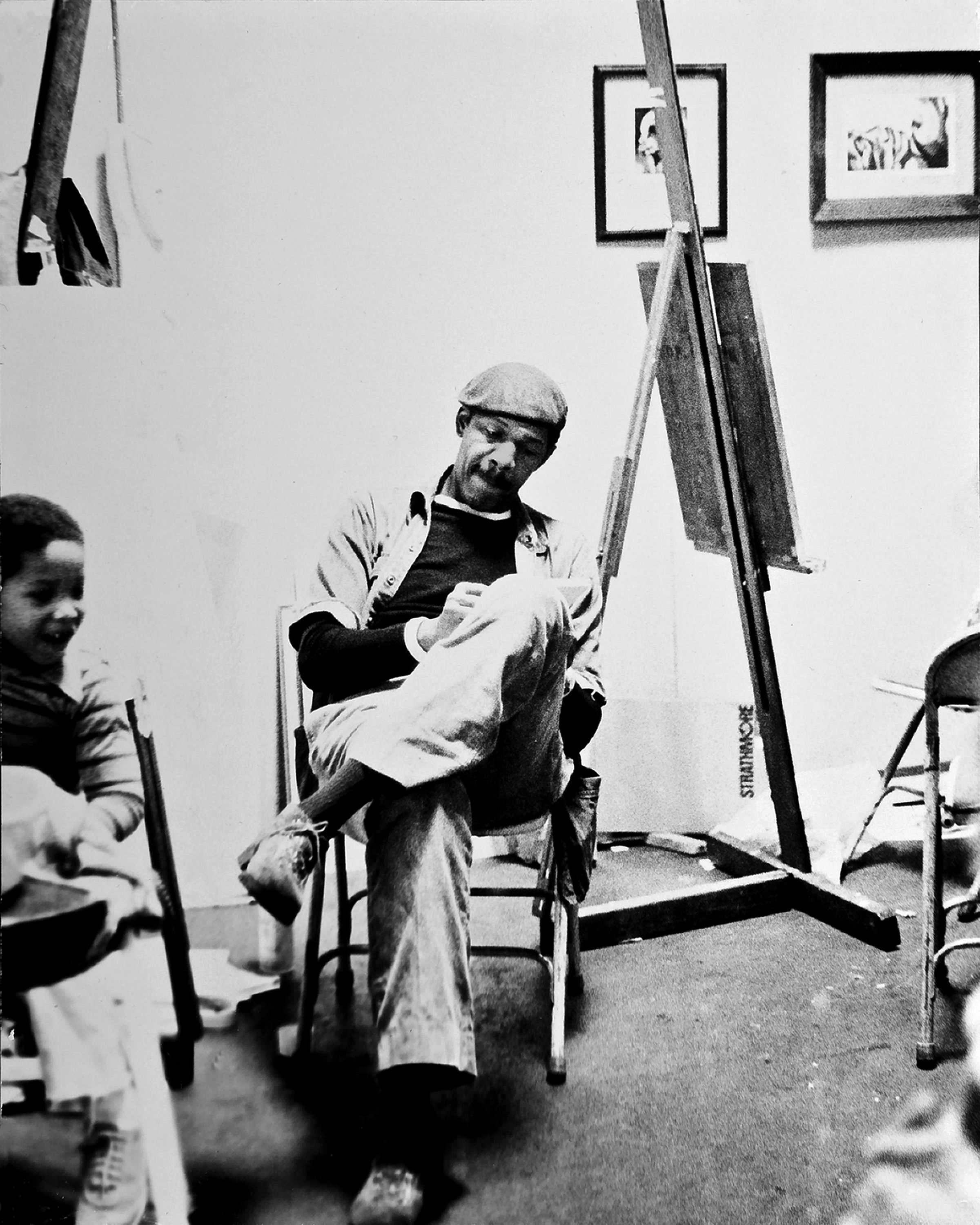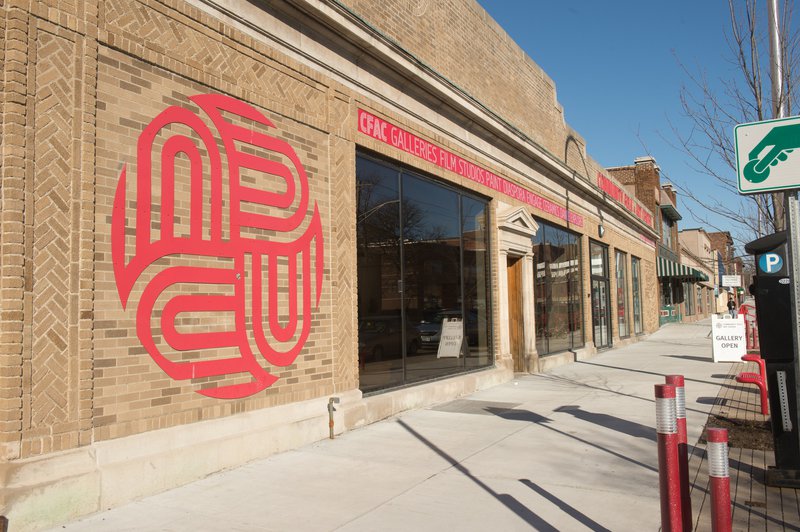CFAC Celebrates 50 Years
The Community Folk Art Center fulfills a mission to bridge campus and the community through the arts.

Habibatou Traore ’24 was in her first weeks at Syracuse University when she heard African drumming during an activities fair for new students last fall. She followed their sound to Joshua Williams, who teaches West African dance and drumming at Syracuse University’s Community Folk Art Center (CFAC). At Williams’ suggestion, the sociology major visited CFAC, and now works there as a work-study student. “The constant celebration of Black excellence, whether it be highlighting visual or performing arts, is inspiring,” she says.
CFAC, a unit of the Department of African American Studies (AAS) within the College of Arts and Sciences, is an arts and cultural organization dedicated to the promotion and development of artists of the African diaspora and other underrepresented groups.
Throughout 2022, CFAC has celebrated its 50-year anniversary, culminating with a luncheon and art auction that was held Oct. 22 and a performance by the Ailey II–Alvin Ailey American Dance Theater at the Landmark Theater on Oct. 26.

“For 50 years, CFAC has helped share, preserve and continue the histories and stories of the African diaspora through the arts,” says Tanisha M. Jackson, Ph.D., executive director and professor of African American studies. “We are proud of the community we serve, the setting we provide for dialogue and interaction and the incredible programs and artists we support.”
In 1972, Syracuse University was actively diversifying its faculty and programs when Herbert T. Williams, a sculptor and art historian, was hired with a dual appointment between the School of Fine Art in the College of Visual and Performing Arts and the fledgling Afro-American studies program.
Williams was asked by Harry Morgan, program director, to create an institution or facility that would engage local Black community members in cultural events and visual arts. That fall, Williams launched a course called Art of the Black World. Students enrolled in that inaugural semester became involved with creating the entity, along with interested local community members.

The result was the Community Folk Art Gallery, which opened its doors in January 1973 in a former bakery on South Salina Street (shown above, courtesy CFAC) on Syracuse’s predominantly Black South Side. The first exhibit featured the work of Harlem photographer James Van Der Zee and poet Quincy Troupe.
The development of the gallery was a grassroots effort. One of the first people Williams involved was ceramicist David MacDonald, who had joined the faculty of the College of Visual and Performing Arts in 1971. “As the only African American faculty member in the art school, he naturally gravitated to me,” recalls MacDonald, who spent 35 years as a CFAC board member, on and off, over the years. “Our mission was to provide the community some access to the resources of the campus and for the campus to gain some knowledge of the kinds of cultural things that were happening in the Black community.”

Others integral to the start of the gallery included nationally acclaimed local artist Jack White, who then taught as an adjunct at Syracuse; undergraduate ceramics major Basheer Q. Alim ’74; and graduate students George Campbell PhD ’77, H’03, a physicist who went on to serve as president of The Cooper Union for the Advancement of Science and Art from 2000 to 2011; and Mary Schmidt Campbell G’73, G’80, PhD’82, president of Spelman College from 2015 until June 2022.
Williams’ students received partial credit for working on gallery programs, acting as guest curators, helping arrange and hang shows, running a Friday night film series, and conducting arts workshops for local residents, who ranged from pre-schoolers to the elderly. One of its oldest community programs is an annual spring art competition for local high school students held in conjunction with The Links, a philanthropic organization for Black professional women.
“This is a shared effort,” said Williams in 1977. “Without SU’s participation, the gallery could not exist. But the community helps establish the programs and policies and benefits directly.”
The gallery moved three times as it outgrew space, expanding its programming each time.

Williams died in 1999. Carol Charles ’84, who had served as associate director under Williams, became managing director. Kheli Willets ’92, G’94, Ph.D.’02, joined CFAC as academic director in 2002 and was named executive director after Charles’ departure in 2008. Both women had been involved with CFAC as SU undergraduates. Charles took Art in the Black World as an undergraduate and later used CFAC facilities as a dancer and with the Paul Robeson Performing Arts Company. Willets was a metalsmithing major who became a work-study student at the gallery, an experience that exposed her to the possibility to teach college and work in a museum that focused on Black art. Working at CFAC inspired her master’s degree in museum studies, a doctorate in art education and a career grounded in African diasporan art and culture.
By then known as the Community Folk Art Center, it moved to its current location across from Syracuse Stage in 2006, becoming part of the University’s Connective Corridor initiative and into the University’s Coalition of Museums and Art Centers (CMAC).
Renovated specifically to serve as an arts space, the new facility features two galleries, one named after Williams, a dance studio, theater (originally home to the Paul Robeson Performing Arts Company), the David MacDonald ceramics studio, and classrooms that can accommodate up to 50 students for its after-school and summer arts academies.
Jackson succeeded Willets in 2019, continuing to expand the arts education center with robust public programming including exhibitions, film screenings, gallery talks, workshops and courses in studio and performing arts, and after-school and summer art programs offered at no charge to local students.
She views CFAC’s role as greater than promoting the arts. “CFAC, in a very organic and genuine way, demonstrates the diversity, equity and inclusion initiatives of Syracuse University,” she says. “We do it in practice and we do it in who we are and how we engage with those themes through exhibitions and programs.”

CFAC's current home at 805 E. Genesee Street, Syracuse.
Kishi Ducre, associate dean of diversity, equity and inclusion for the College of Arts and Sciences and associate professor of African American Studies, says CFAC provides students a unique vehicle to incorporate artistic expression into their scholarship. “One graduate student whose research focused on farmers in Tanzania ended up writing a one-woman show and performing it in the theater as part of her thesis,” says Ducre, who served as a CFAC board member during her tenure as chair of the Department of African American Studies.
It's a perfect fit for Kailey Smith, who serves as a graduate assistant at CFAC as a master’s student in AAS’s Pan African Studies master’s program. While her thesis focuses on museums and the return of stolen African artifacts, her work at CFAC provides a practical perspective to that research. “CFAC has enhanced my studies by allowing me to see what goes on behind the scenes in a museum or gallery setting,” she says. “Those who curate these spaces have to make decisions on what gets displayed and when.”
MacDonald, who retired as professor of ceramics in 2008, attributes CFAC’s longevity in part to health of the Department of AAS. “When we started, the Afro- American Studies program was new and somewhat experimental,” he says. “At many colleges and universities, the courses in those early programs were ultimately absorbed into other academic disciplines, but at Syracuse, the program became a full department. I think that’s played an important role in supporting CFAC, which has provided the instrument to have conversations and to hear voices that you would not normally hear at the average academic institution.”
To learn more about CFAC’s rich history, visit the historical exhibit on display until Dec. 10 that includes archival news articles and photos that highlight the organization’s early years and a retrospective of work from CFAC co-founders.
